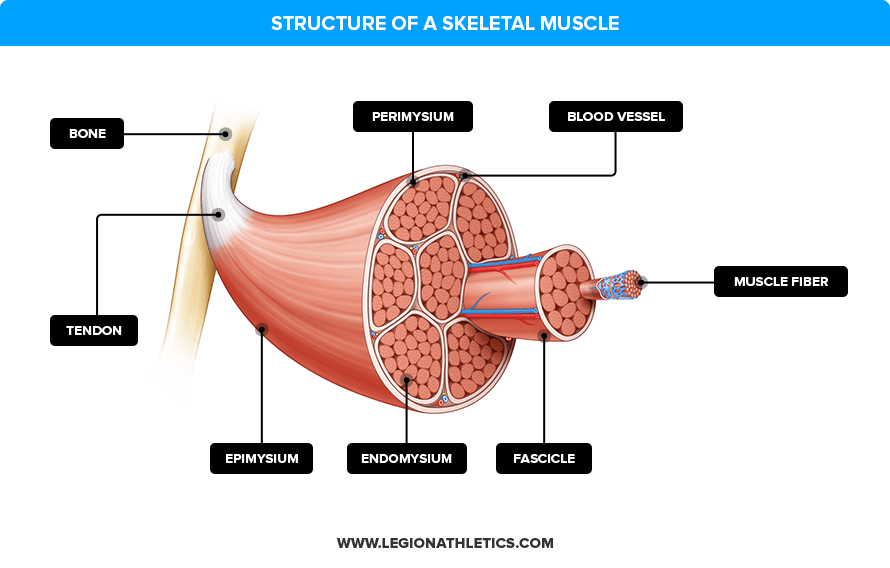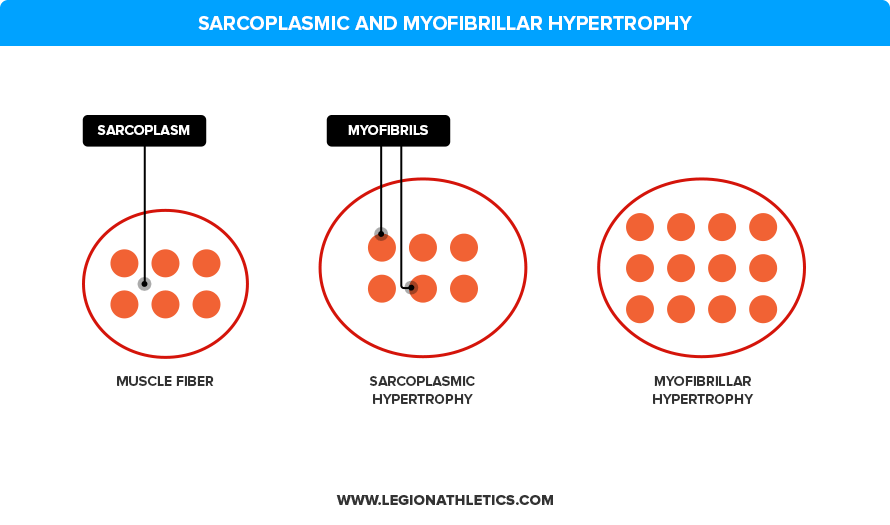Muscle hypertrophy is the scientific term for an increase in muscle size.
Hyper means “over or more,” and trophy means “growth,” so muscle hypertrophy literally means the growth of muscle cells. And in case you’re curious, it’s pronounced hi-per-trophy.
To understand what causes muscle hypertrophy and how it works, you first need to understand what muscles are composed of.
Muscle tissue is a complex structure, with bundles of long strands of muscle cells sheathed in a thick band of connective tissue known as the perimysium.
Here’s how it looks:

The three main components of muscle tissue are:
- Water, which makes up 60-to-80% of muscle tissue by weight. (Want to be creeped out? Read how scientists discovered this.)
- Glycogen, which is a form of stored carbohydrate that makes up 0-to-5% of muscle tissue by weight.
- Protein, which makes up about 20% of muscle tissue by weight.
Theoretically, an increase in any of these components would qualify as “muscle hypertrophy,” but the one weightlifters are most interested in is the third element:
An increase in the amount of protein in the muscle.
This is known as myofibrillar hypertrophy (myo means “muscle,” and a fibril is a threadlike cellular structure).
Another type of hypertrophy is known as sarcoplasmic hypertrophy, which is an increase in the volume of the fluid and non-contractile components of the muscle (glycogen, water, minerals, etc.).
Sarco means “flesh” and plasmic refers to plasma, which is a gel-like material in a cell containing various important particles for life.
Here’s a simple visual that illustrates the difference between these two types of hypertrophy:

Bodybuilders have been debating for years whether sarcoplasmic or myofibrillar hypertrophy is more important for building bigger muscles and what training methods best accomplish this, but here’s the bottom line:
Sarcoplasmic hypertrophy probably does play a small, indirect role in promoting muscle growth, but it’s likely more of a beneficial side effect of proper strength training, not an end to pursue in itself.
In other words, by ensuring you achieve myofibrillar hypertrophy, sarcoplasmic hypertrophy will take care of itself.
And what’s the best way to trigger myofibrillar hypertrophy?
This process involves several steps:
- First, you have to create a lot of mechanical tension in your muscle fibers, and the best way to do this is to force your muscles to contract against external resistance.
- This mechanical tension activates specialized proteins in muscle cells known as mechanosensors. These mechanosensors are only activated by very high levels of tension, which is why low-intensity contractions, like walking, don’t produce a very strong stimulus for hypertrophy.
- Once activated mechanosensors, kicks off a cascade of genetic and hormonal signals that stimulate the body to build new muscle tissue. These signals increase an enzyme in the body known as mammalian target of rapamycin, or mTOR, which boosts protein synthesis (the creation of new muscle fibers).
And voila, you get yourself some new muscle proteins.
In other words, muscle hypertrophy works like this:
Mechanical tension → activates mechanosensors in muscle cells → increases mTOR → boosts muscle protein synthesis → causes hypertrophy → you get swole.
As you might guess, the best way to increase tension in your muscles is to lift heavy weights.
Specifically, you should spend the majority of your time in the gym training with weights that are around 75-to-85% of your one-rep max, or that allow you to do about 4-to-10 reps before reaching muscular failure (the point at which you can’t move the weight despite giving your maximal effort).
What’s more, you also need to produce a sufficient volume of tension over time. For example, although squatting as much weight as possible for a single rep produces a high degree of tension, the duration (volume) of that tension isn’t enough to cause much muscle growth. In other words, there’s a minimum volume of tension required to stimulate muscle growth.
While there’s much debate about the right balance of volume versus intensity for hypertrophy, most research shows that the Goldilocks zone is about 10-to-20 sets per muscle group per week, assuming you’re following the intensity guidelines I just shared.
Now, in order for your workouts to actually build muscle, you also need to give your body enough rest and raw materials to create new muscle tissue, primarily sufficient protein and calories.
If you don’t give your body proper nutrition and sufficient rest, you’ll dampen the anabolic (muscle-building) effects of mechanical tension, reducing the effectiveness of your workouts. What’s more, this also increases muscle protein breakdown—the opposite side of the coin from muscle protein synthesis—which cancels out some of the gains caused by mechanical tension.
If this explanation seems strange to you, I understand.
Look online for what causes hypertrophy, and the description you’ll find just about everywhere is that muscle growth is the result of damaging your muscle fibers with training. Tear down your muscle fibers with weightlifting, give your body a few days to repair the damage, and your body “rebuilds” your muscle fibers to become bigger and stronger.
While this explanation looks tidy on paper, it’s wrong.
There’s still an ongoing debate about whether or not muscle damage actually contributes to muscle growth at all, with most scientists saying that if it does, the benefits are minor, and others saying that it interferes with muscle growth by reducing your ability to produce tension (to use heavy weights for sufficient reps).
The good news is that we don’t need to concern ourselves with this debate, because just about everyone agrees that mechanical tension is still the underlying cause of muscle growth. Although high levels of tension will result in some muscle damage, it’s ultimately the tension that’s driving growth, not the damage.
It’s also sometimes said that cellular fatigue is the third “pathway” for muscle growth, and there’s probably some truth to this.
Cellular fatigue refers to a host of chemical changes that occur inside and outside muscle fibers when they contract repeatedly. When you repeat the same movement over and over again to the point of near muscular failure, this causes high amounts of cellular fatigue.
Research shows that cellular fatigue contributes to muscle hypertrophy in some fashion, but it’s not exactly clear how. It may increase muscle fiber activation, increase cellular swelling, improve the hormonal response to exercise, or work through some other means. The important thing to remember, though, is that mechanical tension is still the prime mover of muscle growth, and that cellular fatigue is a secondary contributor.
Thus, if you want to keep getting bigger and stronger, you want to force your muscles to produce greater and greater levels of mechanical tension in your workouts. The process of doing this is known as progressive tension overload or just progressive overload.
There are several ways to achieve progressive overload in your training, but research shows that the most effective one is adding more weight to the bar (or dumbbells).
As strength training is aimed at improving strength, it follows that it should also be the most effective way to gain muscle (as opposed to other types of training that focus on improving muscle endurance or producing big pumps).
And that’s what a growing body of evidence demonstrates:
Strength training generates large amounts of tension in your muscles, and this produces a more powerful stimulus for muscle growth than traditional “hypertrophy” training. In other words, the best training program for hypertrophy is built around lifting heavy weights in moderate to low rep ranges (around 4-to-10 reps per set).
This isn’t to say that lighter weights and higher rep ranges have no place in your workout routine, but it should always play second fiddle to strength training.
Scientific References +
- BJ, S. (2013). Potential mechanisms for a role of metabolic stress in hypertrophic adaptations to resistance training. Sports Medicine (Auckland, N.Z.), 43(3), 179–194. https://doi.org/10.1007/S40279-013-0017-1
- BJ, S. (2010). The mechanisms of muscle hypertrophy and their application to resistance training. Journal of Strength and Conditioning Research, 24(10), 2857–2872. https://doi.org/10.1519/JSC.0B013E3181E840F3
- DG, A., GD, L., & H, W. (2008). Skeletal muscle fatigue: cellular mechanisms. Physiological Reviews, 88(1), 287–332. https://doi.org/10.1152/PHYSREV.00015.2007
- MC, Z., PC, H., E, J., AV, K., SR, L., YM, P., M, N., LB, P., K, N., & JS, K. (2015). Repeated Bout Effect in Muscle-Specific Exercise Variations. Journal of Strength and Conditioning Research, 29(8), 2270–2276. https://doi.org/10.1519/JSC.0000000000000856
- F, D., CA, L., & C, U. (2018). The development of skeletal muscle hypertrophy through resistance training: the role of muscle damage and muscle protein synthesis. European Journal of Applied Physiology, 118(3), 485–500. https://doi.org/10.1007/S00421-017-3792-9
- KT, M., SL, B., MB, J., SJ, D., JG, M., & JP, L. (2017). Practicing the Test Produces Strength Equivalent to Higher Volume Training. Medicine and Science in Sports and Exercise, 49(9), 1945–1954. https://doi.org/10.1249/MSS.0000000000001300
- E R Helms, P J Fitschen, A A Aragon, J Cronin, & B J Schoenfeld. (n.d.). Recommendations for natural bodybuilding contest preparation: resistance and cardiovascular training - PubMed. Retrieved July 27, 2021, from https://pubmed.ncbi.nlm.nih.gov/24998610/
- Yoon, M.-S. (2017). mTOR as a Key Regulator in Maintaining Skeletal Muscle Mass. Frontiers in Physiology, 8(OCT), 788. https://doi.org/10.3389/FPHYS.2017.00788
- Graham, Z. A., Gallagher, P. M., & Cardozo, C. P. (2015). Focal adhesion kinase and its role in skeletal muscle. Journal of Muscle Research and Cell Motility, 36(0), 305. https://doi.org/10.1007/S10974-015-9415-3
- A L Goldberg, J D Etlinger, D F Goldspink, & C Jablecki. (n.d.). Mechanism of work-induced hypertrophy of skeletal muscle - PubMed. Retrieved July 27, 2021, from https://pubmed.ncbi.nlm.nih.gov/128681/
- BJ, S. (2010). The mechanisms of muscle hypertrophy and their application to resistance training. Journal of Strength and Conditioning Research, 24(10), 2857–2872. https://doi.org/10.1519/JSC.0B013E3181E840F3
- CT, H., CG, V., SC, O., PW, M., PA, R., MA, R., CD, F., CA, J., HA, P., AN, K., JR, M., VLD, B., BM, M., V, I., KC, Y., & MD, R. (2019). Muscle fiber hypertrophy in response to 6 weeks of high-volume resistance training in trained young men is largely attributed to sarcoplasmic hypertrophy. PloS One, 14(6). https://doi.org/10.1371/JOURNAL.PONE.0215267
- KJ, A., Y, S., T, B., K, A., JP, F., & E, J. (1988). Glycogen storage capacity and de novo lipogenesis during massive carbohydrate overfeeding in man. The American Journal of Clinical Nutrition, 48(2), 240–247. https://doi.org/10.1093/AJCN/48.2.240
- Forbes, R. M., Cooper, A. R., & Mitchell, H. H. (1953). THE COMPOSITION OF THE ADULT HUMAN BODY AS DETERMINED BY CHEMICAL ANALYSIS*. https://doi.org/10.1016/S0021-9258(19)52646-1
- Knight, G. S., Beddoe, A. H., Streat, S. J., & Hill, G. L. (1986). Body composition of two human cadavers by neutron activation and chemical analysis. American Journal of Physiology - Endocrinology and Metabolism, 250(2 (13/2)). https://doi.org/10.1152/AJPENDO.1986.250.2.E179










